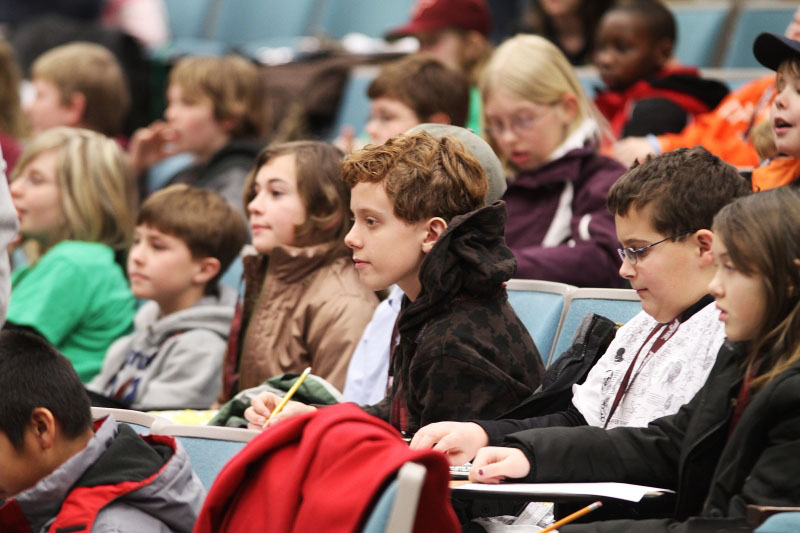Children at Kids' Tech University learn why humans cannot walk on water

This year's Kids' Tech University semester ended with a look at why humans cannot walk on water or climb walls with their fingertips.
Four hundred children, aged 9 to 12, filled McBryde Hall on the Virginia Tech campus, to hear Rafael Davalos, assistant professor in the Virginia Tech-Wake Forest University School of Biomedical Engineering, explain the curious things that happen to nature's forces when engineering and biology take place on a very small scale.
Cathy Sutphin, Virginia 4-H associate director of youth development at the Virginia Cooperative Extension; Skip Garner, executive director of the Virginia Bioinformatics Institute; and Kristy DiVittorio, education and outreach officer at Virginia Bioinformatics Instutute, welcomed the children to the day's events.
Davalos started his talk by giving examples to the children of what engineers do. "Mechanical, electrical, and chemical engineers can build spaceships, design fast computers, and make new energy sources. Civil engineers can help construct skyscrapers and bioengineers can design artificial hip bones or limbs." He added, "That's an impressive list but what all of these activities have in common is teamwork."
The kids heard about how many of the objects we are familiar with, for example airbags in cars, computer printers, or iPods, contain very small devices, microelectromechanical systems -- or MEMS, for short -- that require small-scale engineering to make them work. Davalos went on to explain how such microdevices could be made, a process similar to the way the computer industry makes computer chips.
Said Davalos, "Scientific assumptions from our big world go out the window when you are working in the small world. For example, the capillary forces that we experience when drinking through a straw are stronger than gravity on a very small scale. It's the very way in which physical laws scale that makes it impossible for humans to walk on water or climb walls with their fingertips."
Davalos also unveiled Fred to the children. Fred is a pet dust mite, invisible to the eye but about the size of many of the microdevices that engineers are able to make today. Davalos uses small devices in his own work to help doctors detect cancer at a very early stage. "Cancer starts out as a very small object, something a little bit bigger than Fred the dust mite. In our research group, we are using extremely small devices and our knowledge of forces at small scales to devise ways to detect these cancer cells at a very early stage. The challenge is to detect one cancer cell in as many as one billion or so healthy cells that may be present in the blood."
The children had a lot of questions – from what is the smallest device you have built (about one hundredth the diameter of a human hair) to how do you get rid of cancer cells when you find them? When asked by one child if it were possible to inject the small mechanical devices into people to detect cancer at an early stage, Davalos replied: "You should join our team because that’s exactly one of the things we are trying to do right now."
In the afternoon, the children took part in a wide range of hands-on engineering activities at Cassell Coliseum. These activities included building airplanes, bridges, robots, and toys as well as designing and exploring wood products. Virginia Tech-affiliated clubs, sororities, and fraternities, as well as university graduate students, faculty, and staff hosted these demonstrations.
Reinhard Laubenbacher, director of education and outreach at the Virginia Bioinformatics Institute and founder of Kids' Tech University, concluded: "I would like to thank all the parents and children for their enthusiasm and support of Kids' Tech University. I would also like to take this opportunity to thank all of our speakers, collaborators, and the many volunteers who made the second semester of [Kids' Tech University] such a huge success. We will be working hard to find ways to bring the benefits of this innovative program to an even wider audience in the year ahead."




